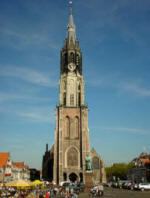 The Nieuwe Kerk, Delft
The Nieuwe Kerk, DelftThe construction of the Delft Nieuwe Kerk (Saint Ursula Kerk, according to the second patron saint of the church) began in 1383 while its elegant tower was begun thirteen years later in 1396. After several interruptions (in 1412 and 1434) the tower was ready exactly one century later in 1496. However, less than fifty years after its completion, it was struck by lightning on May 3, 1536 and burst into flames. Fanned by a strong east wind, the fire spread out of control and devastated virtually everything in Delft west of the Nieuwe Kerk. Part of the tower was burned down, the bells were badly damaged and the roof of the clerestory had collapsed. The spire was re-built in 1537 but the Nieuwe Kerk's bad luck was not over. On October 12, 1654, just after midday, the town was struck by the infamous Delft thunderclap. Ninety thousand pounds of gunpowder exploded in the Delft powder-magazine damaging the walls roof of the Nieuwe Kerk and totally destroying its magnificent stained-glass windows. After immediate restoration, the church could be used again by spring of 1655. In 1872 the spire was again destroyed by lightning. The present spire was built in 1877, bringing the total height of the tower to about 109 meters, which is only surpassed in the Netherlands by the Dom tower in Utrecht.
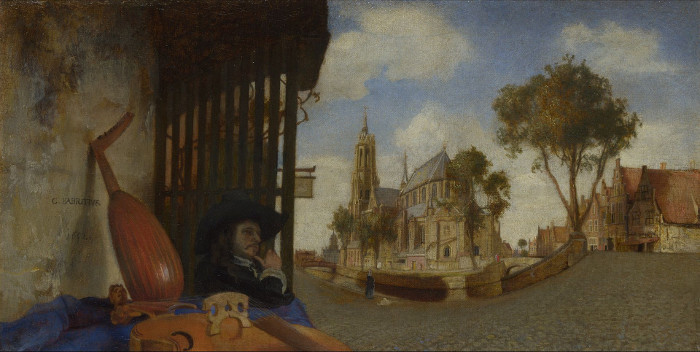
Carel Fabritius
1652
Oil on canvas, 20.9 x 35.7 cm.
National Gallery, London
Between 1436 and 1443, seven bells, cast by Pieter van Dormen from Antwerp, were hoisted and put in place in the Nieuwe Kerk spire. But they were damaged in a fire in 1536 so that the kerkmeesters (churchwarden) had to commission new ones, cast by Joest Cetelaar in Mechelen and the second two by Claes Jansz., a coppersmith. In 1538 the kerkmeesters ordered four swinging bells by the bell founders Geert van Wou and Jan ter Steghe in Kampen near Delft. The founders utilized the remains of the damaged bells as klokspijs (bell metal) and fabricated the new ones between September 1538 and May 1539. They were given the names "Jesus," "Maria," "Ursula" and "Martinus" but unfortunately, they survived only briefly. The Jesus bell broke within the first year, the Ursula broke later and had to be re-cast in 1565, the Maria had to serve as klokspijs for the third cast of the Jesus bell in 1548. The fate of the Martinus is unknown.
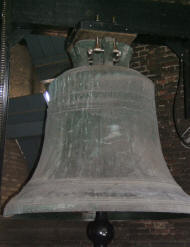
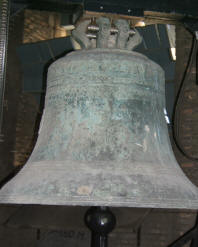 The original Hemony-werkklok of 1662, still serving as luidklok (swinging bell).
The original Hemony-werkklok of 1662, still serving as luidklok (swinging bell).
print maker: Coenraet Decker
Amsterdam and Delft
1678 - 1729
Etching on paper, 3.48 x 27 cm.
After the building was taken over by the Reformed Church in 1572, the use of the bells for the church services declined. However, some years later new bells were commissioned by the town mayors indicating that they had some right to decide about the use of these bells. First, the "Vrijheid-klok," or "Libertas," was cast in 1607 by Jan Burgerhuys from Middelburg (Zeeland). This bell was destined to replace another one which probably was brought to the city hall tower in order to complete a set of chimes. The Libertas was one of the few swinging bells which were not sold in 1808 to relieve a grave financial crisis of the municipality of Delft. During World War II, the Libertas was confiscated, together with many other Dutch bells. It returned to Delft but while it was being hung, it crashed down to the ground and was totally destroyed. In 1955 the bell foundry "Koninklijke Eijsbouts" in Asten cast a copy of the Libertas which still serves its purpose.
In 1662, the master-bell-founder François Hemony, commissioned by the town mayors, cast another swinging bell for the Nieuwe Kerk. It served as a werkklok, to tell the working citizens of Delft when to begin work in the morning and when they were allowed to go home in the evening. Like with the Libertas, the werkklok wasn't sold in 1808, and after World War II it returned safely to Delft, once again hung in the Nieuwe Kerk tower where it still is in function.
After the proclamation of the short-lived Batavian Republic in 1795, the use of the swinging bells declined and a clearer distinction was made between the use of the bells for sacred or for municipal purposes. In 1808, the city of Delft underwent severe financial problems and the mayors were obliged to sell some of the eleven remaining bells in the Oude and Nieuwe Kerk and the city hall. Frederik J. Berghuys, municipal carillonneur in that time, made a detailed inventory with the diameter (measured by himself) and the estimated weight of each of the bells. He proposed to preserve at least two bells per tower, one for the half- and one for the full hour stroke. This meant that five of the eleven bells were sold and six remained in place. One of the survivors was the large Libertas bell of the Oude Kerk, 1570 cast by Hendrik van Trier. For the Nieuwe Kerk these were the Libertas and the Hemony werkklok, as mentioned above. The sale brought the amount of 11,820 gulden.
The "Saint Ursula beiaard" of the Nieuwe Kerk
In 1659, François Hemony was commissioned by the city council of Delft to cast a wachtklok (a bell used by the town waits) which he was able to cast in the same year. Following this successful contact, new negotiations followed concerning a new carillon for the city hall to replace the old one (with 16 resp. 20 bells) which was at the time under restoration. But it was only in 1659 that Hemony offered a first draft for the new carillon with 32 bells in three chromatic sets. The 20 old bells could serve as part of the payment as klokspijs for the casting material of the new bells. In a second letter of May 1660, Hemony made a new offer for the 32 bells with slight differences in their weights. Twenty new bells had already been weighed on 29th April, 1660 and were hung up on 4th May, 1660 but not, according to the original plan, in the tower of the city hall but in that of the Nieuwe Kerk. On the same day Hemony delivered twenty iron forged clappers, a baton keyboard and 19 tumblers for the keyboard. The Delft municipality agreed with Hemony's plan on May 19, 1660, and three days later, on May 22, commissioned another bell with "a0-pitch" for the clock stroke. This large bell together with the twelve remaining bells were delivered shortly thereafter: ten bells were weighed on 8 July and the three largest, among them the "a0-bell," on August 13, 1660. The bells of the second delivery are marked "1660" while the 20 bells from the first delivery are marked "1659." In his second letter Hemony provided detailed information which bells were cast in 1659 and which in 1660.
The clappers for the twelve remaining bells were consigned on 30th August, and in the middle of September 1660 the large bell for the clock stroke was hung up in the tower. Its clapper was finally delivered in March 1661.
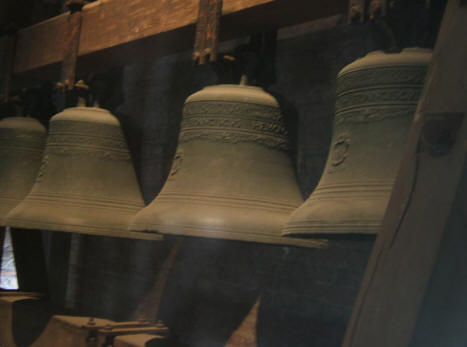
Hemony's new carillon had a tonal range of almost three octaves: from c1 up to a3. As with most seventeenth-century carillons, the bass octave had no Cis and Dis since these notes were seldom in the music of that time (see above Dirck Scholl in the dispute). The carillon is tuned in mean-tone temperament, which was likewise usual in that times for an instrument without the capacity for flexibility of intonation during performance like for instance the string instruments. Roughly put, the mean-tone temperament is a tuning with pure major thirds divided into two equal whole tones. To achieve this, the tuner must temper the fifths and fourths, making the fifths a bit smaller and the fourths a bit larger than pure. It was a frequent keyboard tuning in the Renaissance and the Baroque era.
After the installation of the carillon in the tower with the assistance of the Delft's clock maker Coenraet Harmensz. Brouckman, all the attention turned towards the installation of the automatic chiming system. For this Hemony cast the large drum and delivered it on November 27,1660. But the clockwork from the city hall, made in 1570 by Hendrick van Nuys, had not yet been brought into the tower of the Nieuwe Kerk as it had been planned so Hemony had to delegate the mounting of the entire automatic chiming system to the clock maker Jan van Call from Nijmegen. The 4th December, 1660, the day of a payment to François Hemony, was the last sign of his stay in Delft. Later he gave further instructions in several letters to the havenmeester Bartholomeus van der Mast.
In February 1661 the clockmaker Brouckman moved the clockwork from the city hall to the Nieuwe Kerk tower and delivered a set of new hammers for the automatic chimes. In addition, he fabricated a new clockwork for only two of the three remaining bells there as well as four new clock-faces with hour hands for the Nieuwe Kerk. It took nearly two years until Jan van Call to finish mounting and fitting of the automatic chiming mechanism. When departing from Delft he left a specificatieboek, a book with detailed instructions for the upkeep of the entire system, together with a precise written record of all the work he had performed on the system from October 1661 until May 1663.
Although the carillon had hung in the tower for some time, the responsible authorities waited with the final examinations of the entire system before completing the automatic chiming mechanism as Hemony had suggested in a letter to Van der Mast. These two examinations were held in February and in May 1663 by the experts Alwijn de Vois, organist of the Saint Pieterskerk in Leiden, Johannes Dix (Dyckx), carillonneur in Utrecht, Jan Dircksz. Scholl, carillonneur in Brielle and his son Dirck Scholl, organist and carillonneur in Arnhem and later Delft's renowned municipal carillonneur and organist at the Nieuwe Kerk. Apparently, the new carillon met the approval of both the experts and the municipality. A second carillonneur was employed so that the weekly performances could be extended from three up to eight concerts per week and it is easy to imagine that public listened with the same delight to this wonderful, finely tuned new musical instrument. In Dirck van Bleyswijck's chronicle Beschrijvinge der stadt Delft (1667) we encounter detailed descriptions and understandable praise of both the old chime of the city hall and the carillon in the Nieuwe Kerk. Van Bleyswijck's commented on the choice of melodies played for the new automatic chime thus: "…, zynde veel-tijdts wijsen van psalmen ofte lof-sangen, (…) somtijdts zijn het oock nieuwe airtjes of vermakelijcke lietjes, na de speculatie en fantasie van de meester streckt" ("… frequently melodies from psalms or hymns, […] sometimes there are also new little airs or amusing songs according to the consideration and fantasy of the master").
Two significant extensions of the carillon were made within the next decades. In 1678, Pieter Hemony delivered three bells (bes3, b3 and c4) so that the carillon had a range of three chromatic octaves. The negotiation for and supervision of the exensions were laid down by the municipal carillonneur Dirck Scholl. The bell founder Joris Dumery from Brugge replaced in 1750/51 the g3-bell and extended the carillon in the highest octave with two bells in cis4 and d4 as it had been done with many carillons in the late seventeenth and eighteenth century. For this commission Johannes Berghuys, Delft's municipal carillonneur, served as the mediator. Several restorations of the tower (in 1775 and 1863) required the carillon and its bells had to be removed from the tower.
In 1922, the bell foundry "Koninklijke Eijsbouts" replaced the lichters (levers) of the automatic chiming system and in 1928 essential modifications were made on the baton keyboard and the entire transmission system. During a restoration in 1950, the carillon got its last extension with ten bells so that it has presently a range of 48 bells with a compass of four chromatic octaves. As several bells had gone out of tune due to corrosion caused by an increasing air pollution, Eijsbouts cast twenty copies in the old profile and replaced them in 1963. The twenty old bells, among them 16 Hemony-bells, are exhibited in the first garret of the tower. But 18 original Hemony-bells (including the a0-bell) are still in use and form together with the copies one of Netherlands' most beautiful and authentic seventeenth-century carillons.
Of course, we will never know Vermeer's thoughts regarding the new carillon which was so close to the house where he lived and worked. It is not out of the question that the continual weekly concerts, the playing for official events and festivities, market days, weddings, funerals etc. may have affected his concentration. But the beauty of the old and new melodies performed by such an accomplished musician like Dirck Scholl on this new, well-tuned, excellent instrument may have pleased the artistic sensitivity of Vermeer. After all, it is known that his grandfather musical inspiration was a musician.
Acknowledgements and Closing Thoughts
My special thanks goes at first to Loek W. Boogert, municipal carilloneur of the Peace Palace, The Hague and the carillon in Voorburg, and deputy carilloneur in Delft, who has given me twice the unique chance to visit and explore the carillon of the Nieuwe Kerk in Delft, for all his generosity, invaluable hints and explanations.
Furthermore, I am most grateful to Rainer Schütte, curator of the Nationaal Beiaardmuseum Asten, for the precious time he offered during my visit at the museum, providing me with detailed explanations and further information.
Last but not least, I would like to express my sincerest thanks to Jonathan Janson, who initiated the study, for all his confidence, for the improvement of the texts, the sublime artistic realization and his endless patience with the corrections.
I would like to close this little study to the carillon as the most prominent of Vermeer's daily musical companions with some sentences by Dr. André Lehr.
We have now ended our journey along the rise and the evolution of the carillon since time immemorial. We have seen what has come to us from a distant past and tried to understand it with the material available and with means which are by necessity of the twentieth century. … What once happened we only witness as distant spectators trying to interpret historical facts, trying to order them according to views and ideas which are inevitably borrowed from the present. On the other hand we are linked to this same past in all our musical feelings, because we still listen to bells which our ancestors have also heard, we still listen to music which they too have heard, and we live in a carillon tradition which is deeply rooted in that past.
It seems to be beyond any doubt that a carillon … can fulfill a worldwide symbolic function. The bells of a carillon can also speak a universal language, universally understood, with melodies from all over the world. Bells and carillons sound the way we hear them, time and again they will express our feelings, in sorrow and in joy. … Indeed, bells belong to human beings and they are understood by those who care to listen. May it always be so!
Adelheid Rech
August 2006
Resources:
- Grove Music Online:
http://www.grovemusic.com
entry 'Bells': Hans Klotz / Luc Rombouts
entry 'Zhong-bells': Alan R. Thrasher
entry 'Carillon': Luc Rombouts - André Lehr, together with Wim Truyen and Gilbert Huybens,
The Art of the Carillon in the Low Countries, Tielt 1991. - Laura Johanna Meilink-Hoedemaker, "Luidklokken en speelklokken in Delft," thesis, Utrecht 1985.
- Michigan State University:
Wendell Westcott, Bells and Their Music, 1970, ren. 1998
(esp. chapters 5 and 7)
http://www.msu.edu/~carillon/batmbook/ - Guild of Carillonneurs in North America:
'What is a Carillon?'
https://www.gcna.org/ - Das neue Lexikon der Musik, 4 Bände, Stuttgart-Weimar 1996.
The Carillon in the Web:
- Website van Laura Meilink-Hoedemaker. http://www.laurameilink.nl/
- World Carillon Federation
http://www.carillon.org/eng/fs_cd.htm - Guild of Carillonneurs in North America
http://www.gcna.org/ - Nederlandse Klokkenspel Vereniging
(Netherlands Carillon Association)
https://www.klokkenspel.org/ - Nederlandse Carillon Torens (Netherlands Carillon Towers;
including link list of Flemish carillon towers: Beiaarden in België)
http://www.carillon-towers.net/ - Nationaal Beiaardmuseum Asten:
http://www.carillon-museum.nl/ - Beiaard.be.
Website over beiaardcultuur in Vlaanderen en elders
(website about the art of carillon in Flanders)
http://www.beiaard.be/ - Vlaamse Beiaard Vereniging
(Flemish Carillon Association)
http://www.beiaard.org/